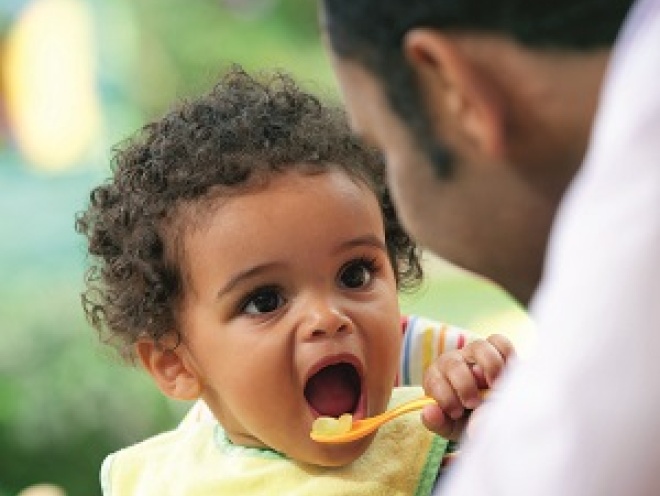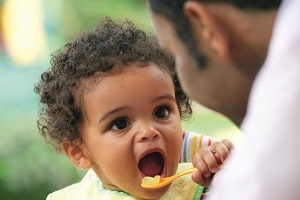Your child might have just started weaning when teething creates a stumbling block. Here we see how teething can affect eating, and how to get through it.
One symptom connected with teething is a decreased appetite for solid foods (Macknin et al, 2000; Lyttle et al, 2015; Eisenstadt et al, 2017). And guess what? You’re likely to start weaning your little one around the six-month mark – the exact same time many babies cut their first teeth (eyes roll again) (Lyttle et al, 2015).
So why do they start fussing all of a sudden? It will come as no surprise that teething causes a lot of discomfort (Eisenstadt et al, 2017).
Where’s my baby’s appetite gone?
Just like us adults can go off our foods when we’re feeling under the weather, so can our little ones. The gums swell and are tender to touch just before a tooth breaks through (Ashley, 2001). So anything in your little one’s mouth could cause more pain.
That said, not all babies lose their appetite when teething. Like with everything else, they’re all different. In fact, the science shows only around one third of teething babies lose their appetite (Macknin et al, 2000).
When will my baby’s teething affect their appetite?
Interestingly, some studies show children lose their appetite with teething only when their canines come through, not when their incisors or molars emerge (Memarpour et al, 2015). Generally, these canines – the pointy ones either side of the front four – appear when your little one is 16 to 22 months old (NHS Choices, 2016a; NHS Devon, 2018).
We know from parents we speak to that many encounter food fussiness earlier than the 16 to 22 month mark. So our practical tips can apply whatever your baby’s age over six months, when weaning starts (NHS Choices, 2018). This guide shows you what to do if your baby is struggling to juggle tooth pain and munching.
Which foods are best when they are teething?
If your baby goes on a feeding strike as they start to cut some teeth, the following should help. It is a case of trial and error here, there’s no right answer. Experiment and see what they seem most comfortable with the following types of foods.
1. Soft foods
Much like us adults might eat nothing but soup after a painful procedure at the dentists, babies might just want to stick with soft foods and purees. Anything they can slurp from a spoon with minimal contact with their gums. A fruit or vegetable puree, or a soft risotto or macaroni cheese (blitzed or slightly overcooked for minimal chewing) could be just the comfort food they need right now.
2. Cool foods
Chilled foods can take the heat out of those burning gums (Ashley, 2001). Yogurt is an easy option here. A ready-made pouch popped in the fridge. Or try some fruit or veg straight from the fridge such as cucumber sticks, a whole strawberry or avocado mushed up.
Just remember foods containing meat, or prepared in advance will need reheating for food hygiene reasons so might not be suitable (NHS Choices, 2015). And make sure you stay with them while they’re eating to watch out for choking.
3. Hard foods
To chew and bite down on have been proven to provide relief in around half of teething babies. Why? Their firmness provides counterpressure to a rising tooth (Memarpour et al, 2015).
Try carrot sticks, whole green beans or sugar snap peas, sliced pepper, breadsticks or bread crusts for babies over six months (Ashley, 2001). As above, just ensure you are on watch to avoid them choking on the chunkier items.
Avoid rusks, because nearly all brands contain some sugar. And sugar can cause tooth decay, even if your child only has a few small teeth (NHS, 2016b). You can read more about how to ease their pain with hard foods and teether toys here.
Does it matter if they are not eating as much as usual?
Try not to worry if not much is going in at any one mealtime. If they are still drinking their usual milk, they’ll be getting nutrients from that. That said, if their hunger strike seems to last more than a few days and you’re worried, see your GP or health visitor.
Try to keep them hydrated. While some babies want to suck and therefore breast or bottle-feed more during a bout of teething (Macknin et al, 2000), others go off the idea. If they are refusing milk or drinking less than usual, try to get them to sip some water, or add milk to their purees. Some parents we speak to also make breast or formula milk lollipops to get milk into their little ones, and soothe their gums at the same time. Win, win.
If they are chewing down on everything, including their bottle teat, try a teether toy instead, which might be more sturdy. If your baby is chewing down on your nipple (hideous), then read our article on feeding and biting.
When will the fussing end?
Your baby will probably have a reduced appetite for solids for the five days ahead of a tooth peeping through, the day it surfaces and for three days afterwards (Macknin et al, 2000). So in general, your baby should be more into their food again in just over a week. That is, unless another tooth is on its way (...you guessed it, another eye roll).
Further information
Our support line offers practical and emotional support with feeding your baby and general enquiries for parents, members and volunteers: 0300 330 0700.
You might find attending one of NCT's New Baby groups helpful as they give you the opportunity to explore different approaches to important parenting issues with a qualified group leader and other new parents in your area.
Make friends with other parents-to-be and new parents in your local area for support and friendship by seeing what NCT activities are happening nearby.
For guidance on how to look after those teeth once they appear (and what foods and drinks they should avoid) read our article on brushing baby’s teethand why teeth hygiene is important for babies.
NCT has partnered with the British Red Cross to offer courses in baby first aid.
Ashley MP (2001) It’s only teething… A report of the myths and modern approaches to teething. Opinion piece. Br Dent J. 191(1):4-8. Available at: https://www.nature.com/articles/4801078.pdf [Accessed on 17th September 2018].
Eisenstadt M, Malkiel S, Pollak U (2017) It’s alright, ma (I’m only teething...) dispelling the myth from the teeth. Acad J Ped Neonatol. 3(4):555618. Available at: https://juniperpublishers.com/ajpn/pdf/AJPN.MS.ID.555618.pdf [accessed 17th September 2018].
Lyttle C, Stoops F, Welbury R, Wilson N (2015) Tooth eruption and teething in children. The Pharmaceutical Journal. 295:7883. Available at: DOI: 10.1211/PJ.2015.20069598 [accessed 17th September 2018].
Macknin ML, Piedmonte M, Jacobs J, Skibinski C (2000) Symptoms associated with infant teething: a prospective study. Pediatrics. 105(4 Pt 1):747-52. Available at: https://www.ncbi.nlm.nih.gov/pubmed/10742315 [accessed 17th September 2018].[1]
Memarpour M, Soltanimehr E, Eskandarian T (2015) Signs and symptoms associated with primary tooth eruption: a clinical trial of nonpharmacological remedies. BMC Oral Health. 15:88. Available at: https://www.ncbi.nlm.nih.gov/pmc/articles/PMC4517507/ doi: 10.1186/s12903-015-0070-2 [accessed 17th September 2018].








